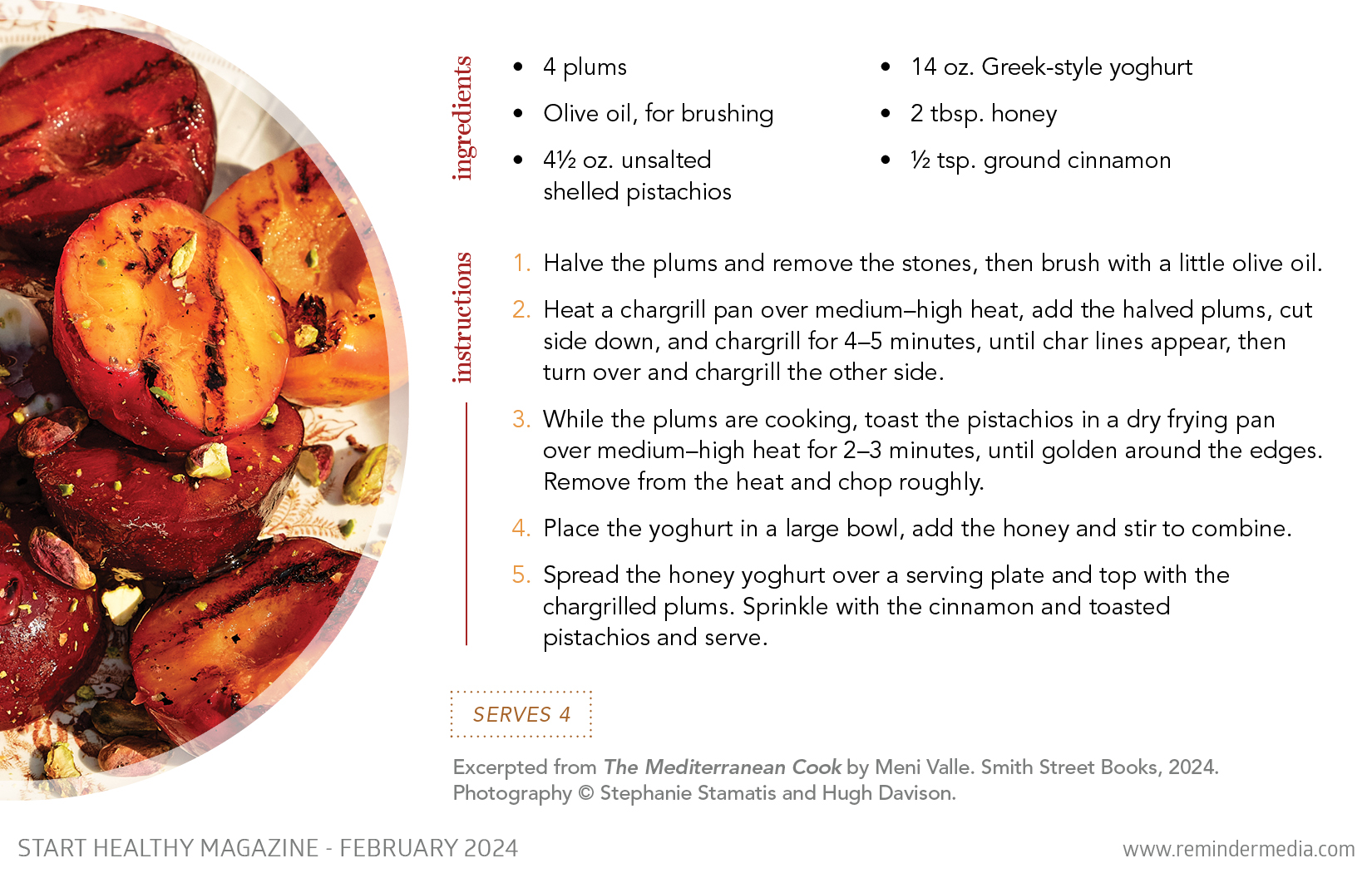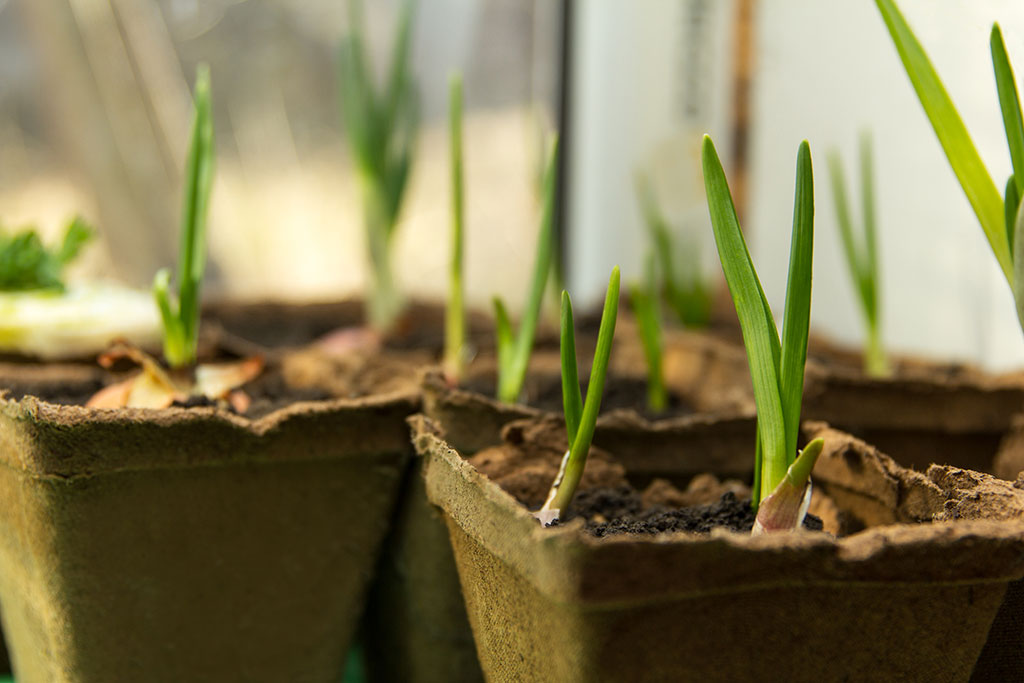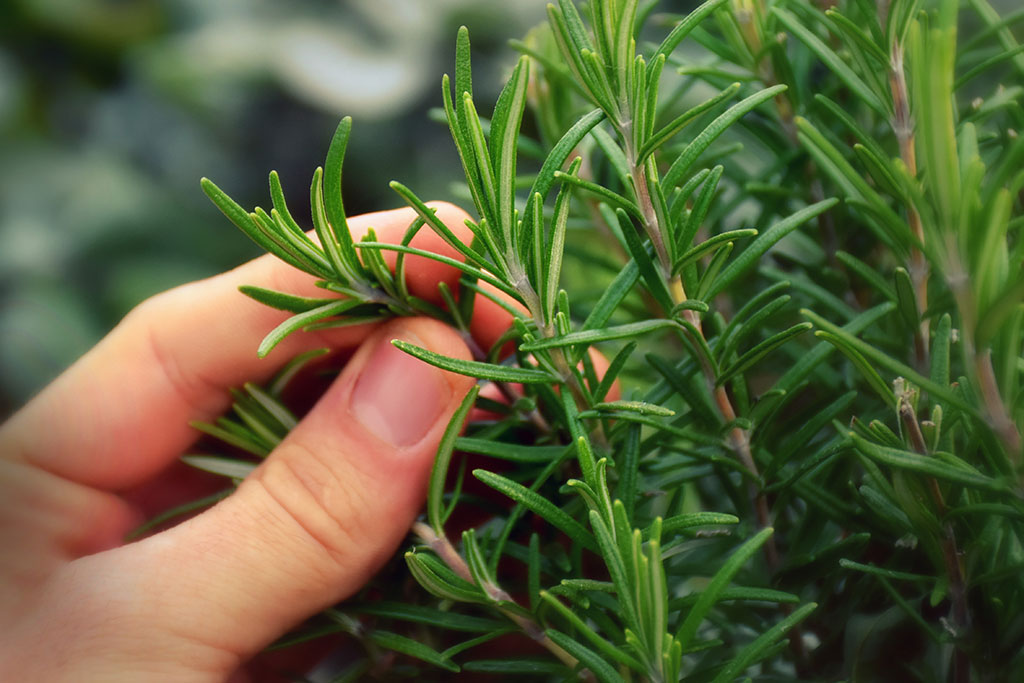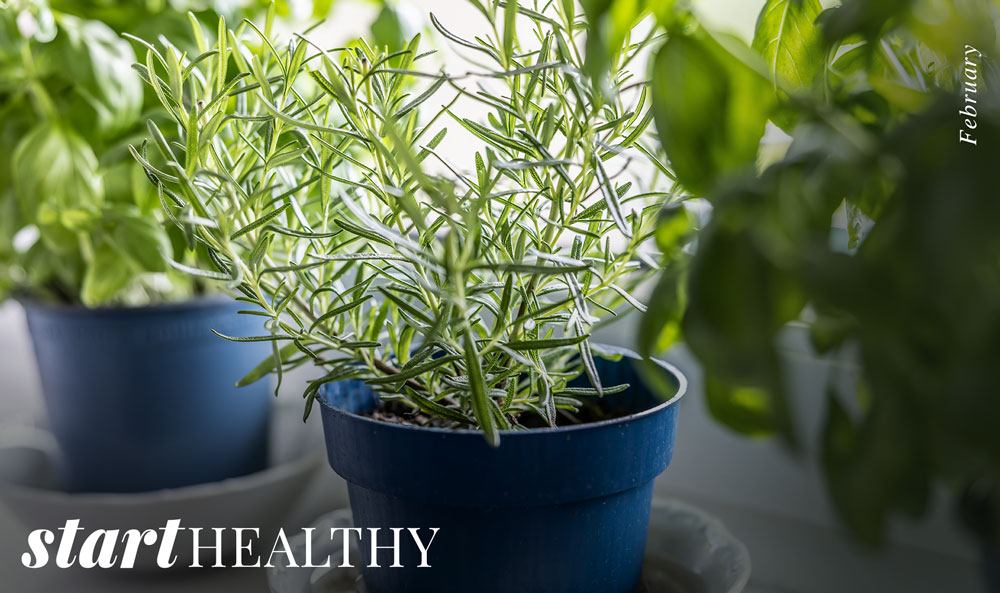While it may still be too chilly to enjoy the outdoors, take a moment to reinvigorate your various routines. This edition of Start Healthy is packed with fresh ideas and tips to help you thrive in the months ahead as you prioritize your well-being. Inside, find fun ways to boost your heart health, explore the benefits of rebounding workouts, discover two delicious Mediterranean recipes, and learn how to cultivate medicinal plants.
With this being American Heart Month, show your heart some love with delightful ways to enhance your cardiovascular well-being. From playing with your pet to showing kindness to others, these simple strategies may help you embrace a healthier lifestyle that keeps your heart in top shape while also bringing you more joy.
Getting tired of your same-old workouts or struggling to find one that doesn't feel like a chore? Consider rebounding on a trampoline, a trending and playful exercise that can both strengthen your muscles and bones, among other benefits, and add some bounce to your fitness routine. Check out the enclosed guide to learn more and find easy tips for getting started.
Take a culinary escape this season with two fresh Mediterranean recipes that will bring vibrant flavors to your table. Enjoy the wholesome ingredients of the hearty lentil soup and chargrilled plums with honey yogurt, each of which will make your mealtime both delicious and nutritious.
Though they may not be foolproof solutions, medicinal plants can offer all sorts of upsides for your health. Inside, discover which herbs and veggies to cultivate for a healing environment, how they can help your overall well-being, and how to grow them successfully.
Here’s to joyful discoveries and healthful living! As always, it’s a pleasure to send you this magazine.
As you shower your loved ones with affection this month, don’t forget to give yourself some much-deserved TLC as well. And what better way to do so during American Heart Month than to embrace activities that boost your cardiovascular health? Exercising and eating a healthy diet are two vital strategies for supporting this critical organ, but as this guide shows, treating yourself to some relaxing, uplifting, and fun pleasures can also yield major advantages.

Though it may be easier said than done, always try to look on the bright side in your day-to-day—doing so can lower your body’s levels of the stress hormone cortisol, reducing your chances of developing hypertension and cardiovascular disease. Consider adopting the method used by Gretchen Rubin, author of The Happiness Project, who found that writing down just one positive sentence daily allowed her to retain happy memories and gain a better outlook on life. Doing the same in your own journal—reporting either your feelings or an event from your day—may allow you to cultivate a greater sense of well-being and ease the stress on your heart.

Going hand in hand with being optimistic is continually seeking opportunities to tickle your funny bone. Laughter can be immensely powerful for your heart, helping to improve blood vessel function and soothe your mood. It may even reduce your risk of chronic inflammation, which is not often associated with heart health but has been shown to spur blood clots, a primary cause of heart attacks and strokes. So always be willing to indulge in a good chuckle, whether you pursue it intentionally, such as by attending a comedy performance, or let it come naturally from watching your kids or grandchildren play or hanging out with good friends.

Kindness isn’t just a virtue; showing it to others can also be good for your ticker in many ways, including by lowering your heart rate and blood pressure. Simple acts like sending a care package to a loved one, checking in on a neighbor, or texting a supportive message to a colleague can increase your levels of the feel-good hormone oxytocin, which can help protect your heart by improving its overall functioning and lowering inflammation. To double down on this benefit, also consider looking into avenues to assist your community or another cause that matters to you.

The healing qualities of nature cannot be overstated. For one, spending time outdoors generally involves getting physically active in some way, such as by walking, kayaking, or biking, strengthening your heart and making it work more efficiently. But even just enjoying the scenery and hearing the sounds of nature—whether outside or on an app like Calm—can increase relaxation to lower your heart rate, blood pressure, and cortisol levels for better cardiovascular health. So take a moment to smell the flowers, listen to the birds in your backyard, or go on a hike for a happier and healthier you.

If you have a pet, spending time with them can offer all sorts of benefits for your well-being. Petting or snuggling with them may provide heart-boosting emotional support and give you an oxytocin rush, while taking them on a walk or indulging in some playtime together can get your blood pumping, making your heart stronger. Owning a pet can also combat feelings of loneliness through companionship and unconditional love, helping to safeguard you against heart attacks and possibly enabling you to live longer.

At the end of a long day, there’s nothing quite like slipping into a cozy pair of pajamas and nestling into your bed for a refreshing night’s sleep. Besides being comforting, getting such rest is essential for your heart health; research shows that falling short of the recommended seven to nine hours a night can damage your cardiovascular fitness, including by raising your blood pressure and contributing to chronic inflammation.
The best way to prevent this is to establish a calming bedtime routine that lets you unwind and readies you for sleep; this could involve anything from sipping some chamomile tea to delving into a good book for twenty to thirty minutes. Also, try to avoid watching TV or scrolling on your phone a few hours before calling it a night since blue light can stimulate your brain and delay restorative REM sleep. It may take some experimentation to find what works best for you, so switch up your approach as needed until you’re regularly waking up energized and alert.
These are just some of the simple and delightful ways you can improve your heart. Pursue what you enjoy most, and you may soon find yourself loving life more overall.
Remember the joy of bouncing on a trampoline as a kid? Well, that childhood fun is back in a big way, but this time it’s all about fitness. Rebounding, a low-impact exercise that involves jumping on a small trampoline, has become rather popular as of late thanks to its many health advantages. It’s an easy and enjoyable approach to working out that may be just the thing to help you stick to a fitness regimen.

Though it may seem like a modern fad, rebounding has a shockingly rich background. It all started in the 1930s with the efforts of Ed Russell, the builder of the first mini trampoline, who bestowed his prototype and ideas upon Victor Green. It wasn’t until the 1970s, though, that Green patented the invention, and soon after, numerous manufacturers were churning out mini trampolines for personal use. One major advocate for them was Albert Carter, a professional gymnast interested in the health advantages of rebounding after training his children with the exercise and seeing their fitness improve immensely. Following intense research, he published his results in two books, the second of which became a bestseller in 1979. And just a year later, NASA verified his assertions with a study demonstrating how rebounding helped astronauts fight muscle atrophy and bone loss after a space mission.
All this spawned an intense craze for rebounding in the early 1980s—but, alas, it didn’t last for long. By 1984, the interest had all but faded thanks largely to the poor quality of the products being sold. But it has found a new resurgence in recent years, perhaps partly spurred by people looking for at-home fitness solutions during the pandemic lockdowns. Jump on the bandwagon, and experience for yourself the proven major health advantages.

Rebounding can provide a broad spectrum of upsides for people of varying fitness levels and ages. As a low-impact exercise, it’s gentle on the joints while also being a great cardiovascular activity, meaning it raises your heart rate and boosts blood flow. This can, in turn, strengthen your heart overall, help oxygen and nutrients get to your cells, and lower your risk of heart disease. And as the NASA study found, it is very effective at increasing bone density, reducing the risk of osteoporosis, and stopping muscular waste. In fact, since you have to constantly engage your legs and core, you can easily build muscle simply through basic jumping.
Additionally, performing this exercise can stimulate your lymphatic system by flushing toxins and other waste products. Just as important, working to maintain equilibrium as you bounce can enhance your balance, coordination, and proprioception—your sense of where your body is in space. Such improvements may be especially valuable for older adults and others at greater risk of falling. (Just make sure to consult with your doctor beforehand and stick to smaller movements, and consider using a handlebar for stability.)
On top of the physical benefits, rebounding also offers many mental health advantages. It is a great approach to lowering stress and raising your spirit thanks to the endorphins, the body’s natural mood boosters, that can be released with the rhythmic bouncing motion. After a few minutes on the trampoline, you may find your anxiety lessening, leading to greater relaxation in the hours that follow. And between that and expending energy, you may enhance your quality of sleep as well.

If you want to get the most out of rebounding, aim to include it in your regular workouts. It can be used for a solo exercise session or for a warm-up before or a cooldown after. The first step is getting the right equipment. When choosing a trampoline for rebounding, look for one that:
Once you’ve got your trampoline all set up and ready to go, ease into the activity by following these tips:

As you grow more confident with rebounding, you can ramp up your workouts by including advanced techniques such as:
As a flexible and fun workout, rebounding is a great choice for any fitness goal, whether you want to increase your cardiovascular health, build muscle, or strengthen your bones. By freshening up your exercise routine with this activity, you can bounce your way to better health in the months ahead.
Many people dream of getting away during winter, but the next best alternative may just be to experience such an escape through food. That’s exactly what these healthy, flavor-filled recipes from The Mediterranean Cook can do for you. With their bold array of flavors, textures, and colors, they’ll whisk you away to a warmer environment with every last morsel.
Chock-full of fresh vegetables, tender lentils, and a dash of vinegar for an added kick, this dish offers a taste explosion you won’t be able to get enough of.
The combination of well-seared juicy fruit, toasted pistachios, and sweetened yogurt will elicit warm-weather vibes.
Excerpted from The Mediterranean Cook by Meni Valle. Smith Street Books, 2024. Photography © Stephanie Stamatis and Hugh Davison.
recipe by meni valle
photos by stephanie stamatis and hugh davison
Winter is a time for warming, soothing meals, and this humble lentil soup with familiar ingredients is one I turn to often. It may seem odd to add vinegar to a soup, but it pairs particularly well with lentils, adding a fresh vibrancy that would otherwise be missing. I encourage you to try it, as it takes this soup to another level.

Serves 4
Make ahead: You can make this soup up to 3 days in advance and store in an airtight container in the fridge. It also freezes well for up to 2 months.




recipe by meni valle
photos by stephanie stamatis and hugh davison
Cooked plums are sweet and juicy, and when served with a honey and yoghurt dressing, they make an effortless dessert.

Serves 4




Long before we began sorting pills in plastic bottles and stirring supplement powders into glasses of water, humans sustained their health with the resourceful use of medicinal plants. Granted, this had mixed results, and modern medicine offers solutions that can’t be found in basic leaves and roots. However, some plant life is still unquestionably linked with bettering our wellness—and science can prove it.
If you’re looking to sustain your health while keeping one foot in nature and enjoying a satisfying hobby, try growing your own remedies at home, whether by tilling them in a dedicated spot in your garden or simply potting them by a window. These are some of the best plants you can cultivate, each of which is easy to grow and packed with benefits.

This popular houseplant has been used as a topical protectant for thousands of years and is pervasive in various skin-care products to this day. The magnificent gel inside each plump leaf is perhaps most well-known for its ability to soothe sunburns and heat-related burns, but it offers virtually endless other skin remedies as well, including improved elasticity, hydration, and general wound recovery. When grown indoors, it can also help cleanse the air of common household toxins and potentially enhance sleep.
Aloe vera is just as hardy as it is healing. Simply plant it in a succulent mix—ensuring good drainage—and in bright, indirect sunlight, water the soil once every two weeks or whenever it’s completely dry, and witness it grow surprisingly quickly. Though aloe can stand up to drought, it’s sensitive to freezing conditions, so it may fare better in an indoor garden depending on your location.

Tangy, fresh-tasting, and reminiscent of pickles, dill offers a long list of medicinal upsides, including improved digestion and insulin management, inflammation reduction, and immune support. Thanks to helpful compounds in the herb, such as flavonoids and tannins, it may even be effective at preventing peptic ulcers and certain cancers.
Dill admittedly won’t be the most beautiful plant in your garden—it’s also referred to as “dill weed,” after all—but the full, dense shrub may be attractive as filler alongside more prominent and decorative plants like flowers. Further, the herb can actually help protect brassica vegetables like brussels sprouts and cabbage from pests (though it has been known to stunt carrot growth for some reason) and attract beneficial insects like black swallowtail butterfly caterpillars. Place it in rich, well-draining, and slightly acidic soil and in a spot that receives full sun; because of these sun-basking needs, however, it may not grow as well indoors.

This is one of the most versatile vegetables on earth and a staple in cuisine worldwide, lending dishes not only a distinct aromatic zing but also various undeniable health benefits. It won’t do your breath any favors, but it has historically been used to help prevent infections, reduce the risk of cardiovascular disease, treat liver disorders, and so much more. It has even been known to aid in preventing cancer.
The Old Farmer’s Almanac recommends replanting individual cloves of garlic, though you’ll want to avoid bulbs from your local grocery store. Place one in fertilized soil in a location that gets six to eight hours of full sun. Additionally, you may want to fence it in to deter your pets since garlic is toxic to them. Spacing, preparation, and care needs for this plant are fairly complex—and vary based on the species you select—but the harvest is well worth the investment.

Though mint is prominently associated with fresh breath (making it especially helpful to those with a vast garlic harvest), the many varieties of this herb—including peppermint, spearmint, and Cuban mint—are as healthy as they are tasty. Each is rich in essential nutrients like iron, fiber, and manganese, and spearmint in particular can be an excellent digestive-health aid when brewed as a tea, offering nausea and stomach discomfort relief.
Given its benefits, distinctly refreshing flavor, and countless culinary uses, it’s no wonder that mint is such a popular herb in home gardens. Then again, that may be unintentional; this incredibly fast-growing and cold-resistant plant has been known to overtake flower beds and even creep into lawns as it thrives. For this reason, it may be best to grow mint indoors or in isolated planters. Use rich, moist, and well-draining soil and pick a spot in partial-to-full sun, then have your garden shears ready for a hefty harvest.

A sharp, needlelike herb that’s packed with flavor and pairs well with meat dishes, rosemary happens to be loaded with health-boosting properties as well. It’s brimming with antioxidants and anti-inflammatory compounds that may enhance your immune system and even increase circulation—an especially important perk for those living with diabetes or certain cardiovascular diseases. It also offers several potential mental enhancements like improved memory, earning it the nickname the Herb of Remembrance.
To raise a rosemary shrub at home, plant it in full sun amid fertile, well-draining planting mix. This drought-tolerant plant is ideal for warm climates, only withstanding temperatures as low as about 15 to 23 degrees. So if you live in a colder region of the country, consider putting it in an indoor pot at a sunny spot. Care for it diligently, and your rosemary may sprout beautiful blue flowers, which are also edible and mildly sweet.
The term “medicinal plant” is certainly a broad one; after all, any fresh produce, including the aforementioned herbs and vegetables, is sure to offer tremendous benefits, fostering both your well-being and your connection to nature. Just remember that while folk medicine and herbal healing have their uses, there’s no replacement for seeing a physician to address your health-care needs. But sprinkling in some doctor-approved natural remedies could be an underutilized strategy to preserving your daily wellness.








